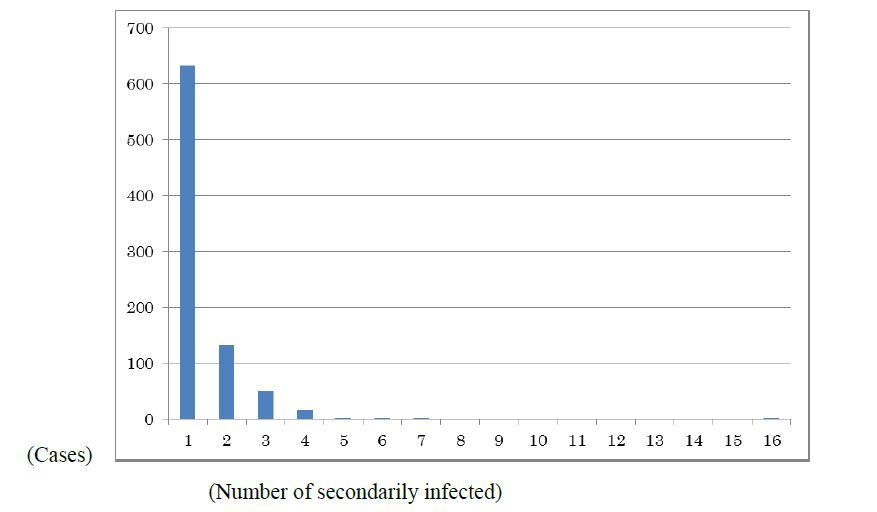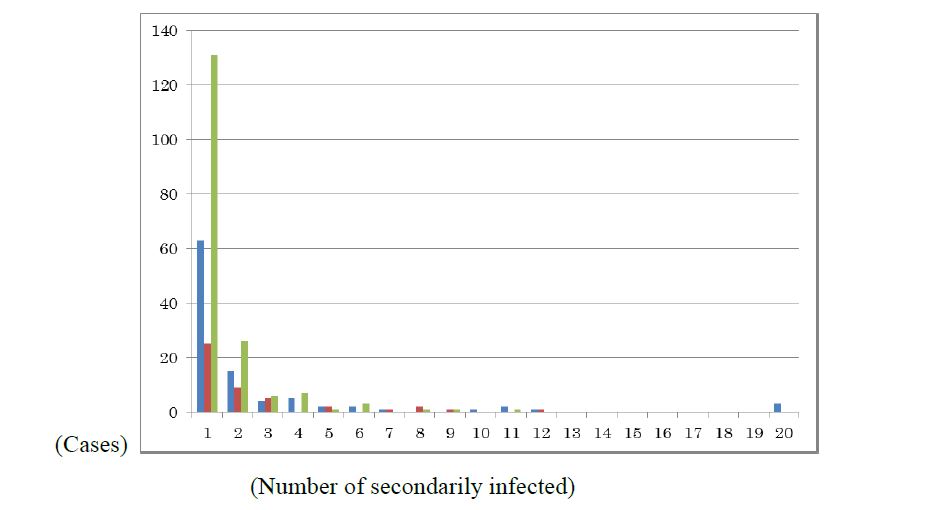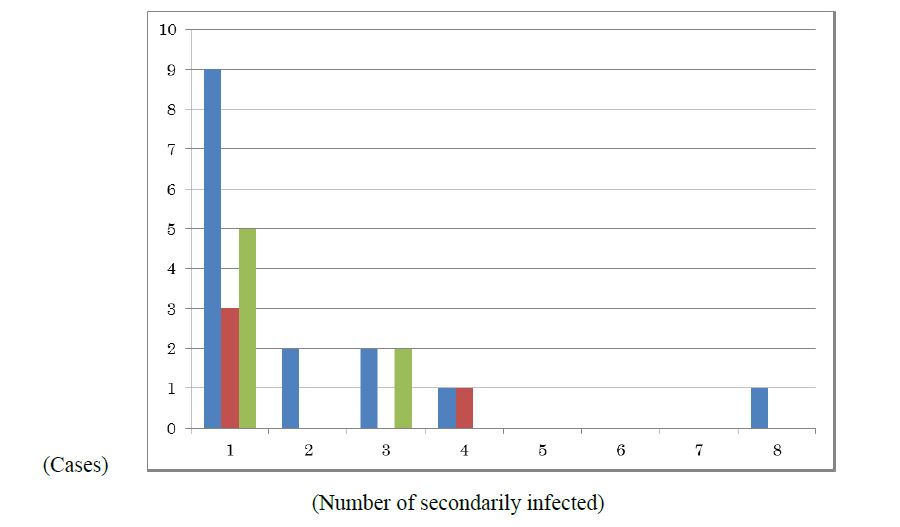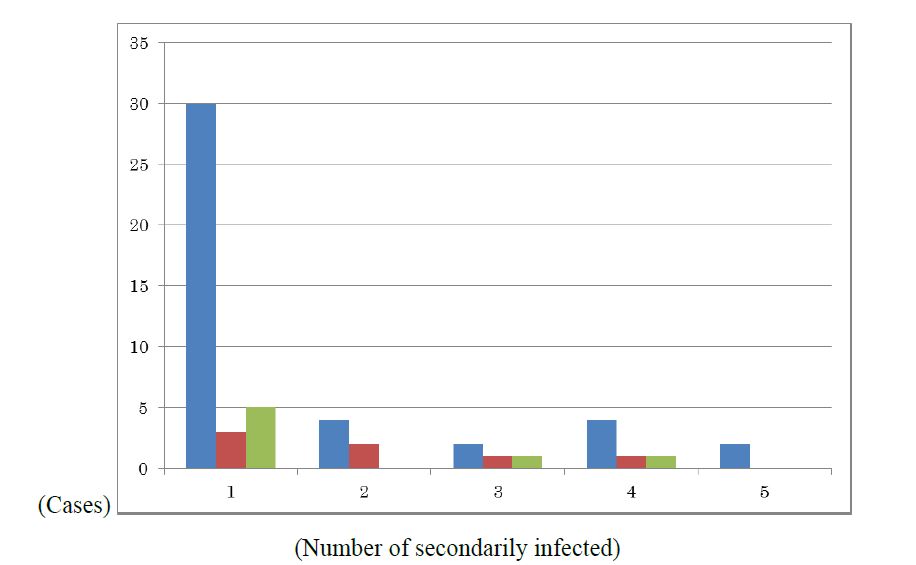Journal Name: Journal of Health Science and Development
Article Type: Research
Received date: 15 April, 2021
Accepted date: 23 June, 2021
Published date: 2024-02-01
Citation: Hata A, Kurita J, Hata T, Sugawara T, Ohkusa Y (2021) Estimating SARS-CoV-2 Reproduction Number by Infection Location in Japan. J Health Sci Dev Vol: 4, Issu: 1 (24-29).
Copyright: © 2021 Hata A et al. This is an open-access article distributed under the terms of the Creative Commons Attribution License, which permits unrestricted use, distribution, and reproduction in any medium, provided the original author and source are credited.
Abstract
Background: COVID-19 infectiousness might differ by infection location. Nevertheless, no such study of infectiousness has been reported.
Object: The study objective was estimation of the reproduction number by infection location.
Methods: We used information from press releases issued by the Ministry of Health, Labour and Welfare from January 15 through the end of July, 2020. On the assumption that the probability of the secondary infection decreases exponentially as the number of secondary infection from the same patient, we estimated the reproduction number from the histogram of the number of people infected by the same patient. We considered homes, hospitals, and facilities for elderly people, workplaces, schools, nursery schools, universities, restaurants, night entertainment venues, and karaoke as infection places. The study period extended from January 15 through the end of July, 2020.
Results:Among 36,431 patients in Japan, 4886 cases were identified as infection sources. Their necessary information was published by the government. Among the considered locations, only the estimated reproduction number at homes, 2.4752 (95% confidence interval [1.2943, 6.7998]), and at hospitals, 7.0849 ([3.2501, 28.9211]) were significantly greater than one. The estimated infectiousness at facilities for elderly persons, 3.2267([0.9927, 29.4718]), was significantly greater than one, but only marginally.
Discussion and Conclusion:Results emphasize that countermeasures to control COVID-19 must be taken against infection at homes, hospitals, and facilities for elderly persons, where the reproduction number was significantly greater than one.
Keywords:
COVID-19, Home, Hospital, Infection location, Reproduction number, Restaurant, School.
Abstract
Background: COVID-19 infectiousness might differ by infection location. Nevertheless, no such study of infectiousness has been reported.
Object: The study objective was estimation of the reproduction number by infection location.
Methods: We used information from press releases issued by the Ministry of Health, Labour and Welfare from January 15 through the end of July, 2020. On the assumption that the probability of the secondary infection decreases exponentially as the number of secondary infection from the same patient, we estimated the reproduction number from the histogram of the number of people infected by the same patient. We considered homes, hospitals, and facilities for elderly people, workplaces, schools, nursery schools, universities, restaurants, night entertainment venues, and karaoke as infection places. The study period extended from January 15 through the end of July, 2020.
Results:Among 36,431 patients in Japan, 4886 cases were identified as infection sources. Their necessary information was published by the government. Among the considered locations, only the estimated reproduction number at homes, 2.4752 (95% confidence interval [1.2943, 6.7998]), and at hospitals, 7.0849 ([3.2501, 28.9211]) were significantly greater than one. The estimated infectiousness at facilities for elderly persons, 3.2267([0.9927, 29.4718]), was significantly greater than one, but only marginally.
Discussion and Conclusion:Results emphasize that countermeasures to control COVID-19 must be taken against infection at homes, hospitals, and facilities for elderly persons, where the reproduction number was significantly greater than one.
Keywords:
COVID-19, Home, Hospital, Infection location, Reproduction number, Restaurant, School.
Introduction
Since the emergence of COVID-19 in December, 2019 in Wuhan, China, reproduction numbers, which are averages of the number of people infected from a patient in the entire period of infectiousness, have been estimated several times. Some of the earliest studies conducted in Wuhan estimated R0 for COVID-19 as 2.24–3.58 [1-3]. Even in Japan, early research estimated R0 as 2.534 (95% confidence interval (CI) [2.449, 2.598]) [4].
However, these reproduction numbers were for whole populations. Reproduction numbers by location of infection are less known, but infectiousness probably differs among infected places. As one instance, countermeasures under the second emergency status declaration on January 7, 2021 stipulate clearly that restaurants close earlier than eight o’clock p.m. This policy was based on an inference that infectiousness at restaurants was higher than in other areas. By contrast, nursery schools and schools were not required to close as a countermeasure, although they had been closed under the first emergency declaration extending from April 8 to May 24, 2020. These different countermeasures by location might be based on an earlier mobility network study in US [5]. That study found that full service restaurants had the highest infection and that new car dealers had the lowest infection rate among the considered places. However, the study did not evaluate risk of infection at each place or type of place directly. The study observed simply that persons in the higher infection place had higher likelihood of visiting an area with full service restaurants having higher density of visitors. In other words, they used no data related to how often and many persons had been infected in the full service restaurant.
Another study investigating experiences in Europe countries suggested that the effects of ban in bars and restaurants were limited. Because it was cross-sectional analysis, it also did not measure infectiousness directly by the type of place [6]. The objective of the study was confirmation of differences in infectiousness by infection location using infection record with source of infection through contact tracing by which a public health center investigates close contact with patients and sources of infection of the patients.
A study conducted to estimate infectiousness in the earlier stage of the outbreak in Japan included patients who were not reported as having infected someone [7]. They estimated a very small reproduction number as of the end of February in Japan: 0.6. Although they did not designate it as R0, they referred to it as the average number of secondary infections. Such a low number indicates that the outbreak of COVID-19 would be self-limited. Therefore, any intensive infection control such as school closure or restriction against going out can be expected to be unnecessary. The authors of that report apparently misunderstood the meaning of patients who were not reported as having infected someone. Such people might have been underestimated severely at that time. People they infected might have been found and reported. Alternatively, investigation of them cannot simply reveal who had been infected by them. Therefore, we proposed another method of estimating infectiousness. The reproduction numbers we defined are averages of the number of people infected from a patient in the entire period of infectiousness. It excluded information of patients who were reported as not having infected anyone [8].
Methods
We adopted a similar method to estimate infectiousness by location of infection, as in our earlier study, which investigated infectiousness by age of the infected person and age class inferred from the infection source [8].
We chose to examine major places where people were being infected: homes, hospitals, facilities for elderly people, workplaces, schools, nursery schools, universities, restaurants, night entertainment venues, and karaoke. For this study, the School category includes no nursery schools or universities, but it does include kindergartens, elementary schools, junior high schools, and high schools. In addition, the Restaurant category does not include night entertainment venues or karaoke.
Let xi, represent the number of cases in which j patients were infected secondarily in place i. We do not know the probability by which a patient infected one person. Therefore, the probability that a person infected one or more people was assumed to decrease exponentially as the number of secondary infection from the same patient as pi,p_i^2, p_i^3,and so on.Then Ri= pi+2p_i^2+3p_i^3+…=Σk=1 k p_i^k=pi/(1-pi)2.
We observed an estimator of pi, as xi,1/Ni, where Ni, represents an unknown total number of primary cases who infected at place i. Similarly, p_i^2 was estimated as xi,2/Ni and p_i^m= xi,m/Ni. By log transformation, we have m log pi= log xi,m – log Ni (m=1, 2,…M) where M stands for the maximum number of secondary infections. Therefore, we obtain an estimator of p as an estimated coefficient of regression of log xi,m on m using ordinary least squares method. In addition, the total number of primary cases was estimated from an exponential transform for the estimated constant term.
The confidence interval (CI) of Ri,* was obtained using a non-parametric fully replicated bootstrapping method based on empirical distribution for the distribution of {xi,m (m=1, 2, …L i)}, where Li, stands for the maximum number of non-zero secondary infections [9-11]. In addition to bootstrapping, we used the method with special consideration for the case of xi,m=0 (m=1, 2, …Li). These cases were ignored in estimation despite including much information. We bootstrapped for the distribution of {xi,m+1 (m=1, 2, …Li)} and produced an estimate using max[0.001,{xi,m+1}b-1](m=1,2, …Li), where superscript b denotes a bootstrapped series and where 0.001 represents a small number used for calculations instead of 0.
Based on the j-th bootstrapped distribution {xi,m (m=1, 2,…)}j, one can obtain Ri,j *. We repeated this procedure one million times, thereby obtaining one million bootstrapped Ri,j *. We sorted these variables. The duration from Ri,25000 * to Ri,975000 * is expected to be 95% CI of Ri *.
All information used for this study was obtained from press releases issued by the Ministry of Health, Labour and Welfare [12]. The study period extended from January 15, when the initial case was detected in Japan, through the end of July.
Ethical Considerations
All information used for this study has been published as press releases [12]. There is therefore no ethical issue related to this study. We used the level of 5% to infer significance.
Results
Through the end of July, 36,431 patients had been confirmed in Japan. From those, after excluding asymptomatic cases, cases of people presumed to have been infected in foreign countries, and cases for which no onset date was available, we were left with 30,780 cases. Of those cases, after excluding cases for which the infection source was unknown, and cases for which the age of patients and sources of infection were unavailable, we were left with 5383 cases. Of those cases, 4886 were identified as infection sources. These 4886 cases were analyzed for this study.
Figure 1 presents a bar chart of cases by the number of secondary infections at home. Figure 2 depicts infection cases related to hospitals, facilities for elderly persons, and workplaces. It is noteworthy that three cases showing 20 secondary infections in a hospital represented more than 20 secondary infections. Figure 3 portrays those in schools, nursery schools, and universities. Figure 4 presents those in restaurants, night entertainment venues, and karaoke.
Estimation results of Ri are presented in table 1. Regarding median values, hospitals were found to be the highest, followed by universities and facilities for elderly people. Night entertainment venues were the lowest, followed by nursery schools, schools, and workplaces. Among considered locations, only the estimated reproduction number at home were significantly higher than one. However, except for homes, 2.4752 ([1.2943, 6.7998]) and hospital 7.0849 ([3.2501, 28.9211]), the lower bounds of 95% CI of all other sites were less than one. The estimated infectiousness at the facilities for elderly persons, 3.2267 ([0.9927, 29.4718]), was marginally significantly higher than one. In other words, their infectiousness was not significantly different from that other than hospitals, homes, and facilities.
Discussion
We used a procedure to estimate the case distributions among numbers of infected cases developed in our earlier study [7]. Although infected cases or unlinked cases for which the infection source was unknown represented most cases, the procedure we used ignores information from those cases because it was less credible. However, information about patients who were reported as having infected someone was more reliable than others because, at least, they had been investigated by public health authorities.
Applying our proposed procedure for the present study to data obtained from an earlier study, we obtained a figure of 4.4273. Its 95% CI was [3.6000, 5.3364]: more than six times greater than the original estimate [7]. That finding was comparable to results we obtained for infections from adults to elderly people and from elderly people to adults. They apparently underestimated R0. Therefore, the chosen infection-control policy was misguided, with insistence on contact tracing.
Results demonstrated that the estimated infectiousness at hospitals and homes was significantly greater than one. Infectiousness at facilities for elderly people was marginally greater than one. Infectiousness at the other considered places was not significantly greater than one. Particularly, the estimated infectiousness in restaurants was not high. Therefore, rather than restaurants, countermeasures for COVID-19 should specifically examine hospitals, some other considered places, or homes.
It is noteworthy that infectious areas identified based on the present study do not represent a hot spot at which numerous people were infected. The total number of people infected in a type of place represents the product of infectiousness and people who are infectious visiting and staying at a place. For instance, although infectiousness at homes was less than at other places, numerous patients stayed at home and shared contact with family members. For those reasons, one would expect that people infected at home would be much more numerous than at other places: they were. When interpreting the obtained results, one must be reminded that infectiousness represents an average number of secondarily infected people per infectious person.
Figure 1:Numbers of cases at home by number of secondarily infected. Note: Bars represent numbers of people infected at home.
Figure 2:Numbers of cases infected at hospitals, facilities for elderly people, and workplaces by number of secondarily infected. Note: Blue bars represent the number of the infected cases at hospitals. Orange bars represent those at facilities for elderly people. Gray bars represent those at workplaces. Infections at hospitals include cases in which 21, 34, or 57 were secondarily infected. In the figure, these three cases were added together as 20 secondarily infected.
Figure 3:Numbers of cases infected at schools, nursery schools, and universities by number of secondarily infected. Note: Blue bars represent the number of the infected cases in school. Orange bars represent those at nursery school. Gray bars represent those at university. Schools do not include nursery schools or universities, but include kindergartens, elementary, junior high, and high schools.
We have examined advanced bootstrapping procedures with special consideration for some particle numbers of secondary infection recording zero cases. For estimation in the present study, information about the number of secondary infections was ignored because log transformation of the number of cases was used. However, the likelihood of one case at a particular number of secondary infections actually leading to zero cases was probably less, but it was a comparable likelihood to that of one case at a particular number of secondary infections actually recording one case in a bootstrapping procedure. Therefore, we treat those numbers of secondary infections recording zero cases with special consideration.
Figure 4:Numbers of cases infected at restaurants, night entertainment venues, and karaoke by number of secondarily infected. Note: Blue bars represent the number of people infected at restaurants. Orange bars represent those infected at night entertainment venues. Gray bars represent those infected at karaoke. Restaurants do not include night entertainment venues or karaoke.
Table 1:Estimated results of effective reproduction number by infection location.
| Median | 95% CI | ||
|---|---|---|---|
| Lower bound | Upper bound | ||
| Home | 2.4752 | 1.2943 | 6.7998 |
| Hospital | 7.0849 | 3.2501 | 28.9211 |
| Facility for elderly people | 3.2267 | 0.9927 | 29.4718 |
| School | 1.2331 | 0.3160 | 39.8456 |
| Nursery School | 1.1580 | 0.0453 | 67.5018 |
| University | 3.2321 | 0.2011 | 48.2487 |
| Restaurant | 2.9824 | 0.1462 | 17.2831 |
| Night entertainment | 0.6481 | 0.0374 | 67.5018 |
| Karaoke | 2.0143 | 0.0391 | 42.4974 |
| Workplace | 1.3161 | 0.4993 | 6.7833 |
| Note: “School” includes kindergartens, elementary schools, junior high schools, and high schools. “Restaurant” excludes “Night entertainment” and “Karaoke.” | |||
The present study has some limitations. First, because infectiousness in all places was not significantly different, data might be insufficient to apply our procedure. When we accumulate sufficient data, it might be solved partially.
Second, because of data limitations, we cannot analyze characteristics such as those of patients or hospital staff, residents or staff at a facility for elderly persons, or students and teachers at a school. For example, infectiousness among students in school or among kids in nursery school, or of medical staff to patients are probably very important factors to elucidate when controlling an outbreak. To resolve that difficulty to some degree, data accumulation is expected to be necessary in the near future.
Thirdly, seasonality of infectiousness might be fundamentally important, as it has come to be for influenza. Because data used for this study were accumulated through July, we are unable to evaluate them. In winter, data must also be analyzed similarly. Risk related to location must be evaluated.
Fourthly, for simplicity, we assumed that the probability of a person infecting one or more people was assumed to decrease exponentially. However, it might be too restrictive and lead to biased results. We must check the robustness of this assumption by examination of other specifications about a bar chart of the number of secondary infections.
Fifthly, we did not consider congestion, ventilation, wearing masks, or other factors that are probably associated with infectiousness at restaurants, schools, offices, and other places. Such factors might be important to ascertain infectiousness. Nevertheless, because we do not know these conditions at each potential infection location, we cannot evaluate infectiousness at individual locations. In other words, for the present study, we assumed that individual locations have an average condition probably associated with infectiousness by type of location.
Sixthly, the upper bands of the 95% CI in the considered places were large. The width of the upper band is probably attributable to the small sample for each place. Therefore, increased data accumulation might solve this shortcoming. Heterogeneity might exist in the considered places. As an earlier study indicated, full-service restaurants, limited service restaurants and cafes might be much different in terms of the risk of infectiousness, for instance [5]. Because our data had no information about restaurant types, we cannot understand the type of restaurant immediately. However, that point remains as the next challenge for our future study.
Conclusion
This study demonstrated that effective reproduction numbers at restaurants were not so high but with a very wider confidence interval. Results show that the median of the estimated reproduction number is comparable to those of universities or karaoke. No significant difference in infectiousness was found among the places considered. In other words, we must emphasize the study of infection at homes, hospitals, and the facilities for elderly persons, for which the reproduction numbers were significantly higher than one, to control the spread of COVID-19.
The present study is based on the authors’ opinions: it does not reflect any stance or policy of their professionally affiliated bodies.
Acknowledgment
We acknowledge the great efforts of all staff at public health centers, medical institutions, and other facilities who are fighting the spread and destruction associated with COVID-19.
Ethical Considerations
All information used for this study was collected under the Law of Infection Control, Japan and published data was used. There is therefore no ethical issue related to this study.
Competing Interest
No author has any conflict of interest, financial or otherwise, to declare in relation to this study.
Zhao S, Lin Q, Ran J, Musa SS, Yang G, et al. (2020) Preliminary Estimation of the Basic Reproduction Number of Novel Coronavirus (2019-nCoV) in China from 2019 to 2020: A Data-Driven Analysis in the Early Phase of the Outbreak. Int J Infect Dis 92: 214-217. [ Ref ]
Liu Y, Gayle AA, Wilder-Smith A, Rockly J (2020) The reproductive number of COVID-19 is higher than SARS coronavirus. J Travel Med. [ Ref ]
Lai C, Shih T, Ko W, Tang H, Hsueh P (2020) Severe Acute Respiratory Syndrome Coronavirus 2 (SARS-CoV-2) and Coronavirus disease-2019 (COVID-19): The Epidemic and the Challenges. Int J Antimicrob Agents 55: 105924. [ Ref ]
Sugishita Y, Kurita J, Sugawara T, Ohkusa Y (2020) Effects of voluntary event cancellation and school closure as countermeasures against COVID-19 outbreak in Japan. Plos one 15: e0239455. [ Ref ]
Chang S, Pierson E, Koh PW, Gerardin J, Redbird B, et al. (2021) Mobility network models of COVID-19 explain inequities and inform reopening. Nature 589: 82-87. [ Ref ]
Post RAJ, Regis M, Zhan Z, van den Heuvel ER (2021) How did governmental interventions affect the spread of COVID-19 in European countries? BMC Public limited. Health 21: 411. [ Ref ]
Nishiura H, Oshitani H, Kobayashi T, Saito T, Sunagawa T, et al. (2020) COVID-19 Response Team. Closed environments facilitate secondary transmission of coronavirus disease 2019 (COVID-19). medRxiv. [ Ref ]
Kurita J, Hata T, Sugawara T, Ohkusa Y, Hata A (2020) An Estimation of Reproduction Number of SARS-CoV-2 by Age Class for Age Classes in Japan. medRxiv. [ Ref ]
Davison AC, Hinkley DV (1997) Bootstrap Methods and Their Application, Cambridge University Press Cambridge. [ Ref ]
Mooney Z, Duval RD (1993) Bootstrapping: A Nonparametric Approach to Statistical Inference. Sage Publication, CA. [ Ref ]
Efron B, Tibshirani RJ (1993) An Introduction to the Bootstrap. Chapman & Hall, New York. [ Ref ]
Japan Ministry of Health, Labour and Welfare (2020) Press Releases. [ Ref ]






